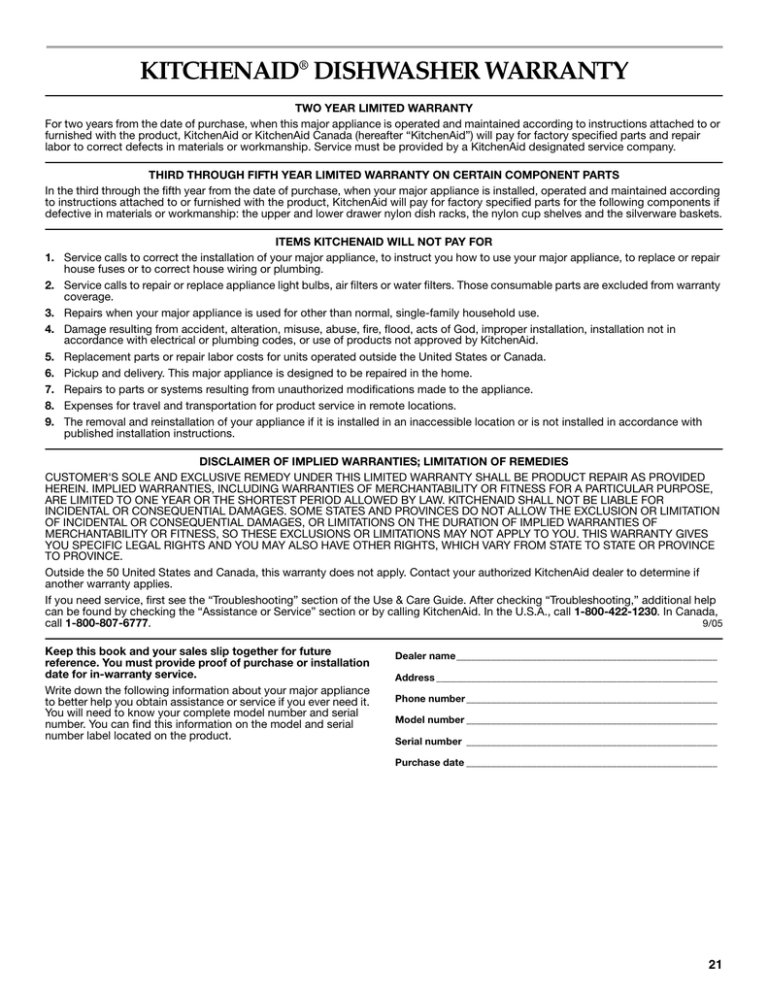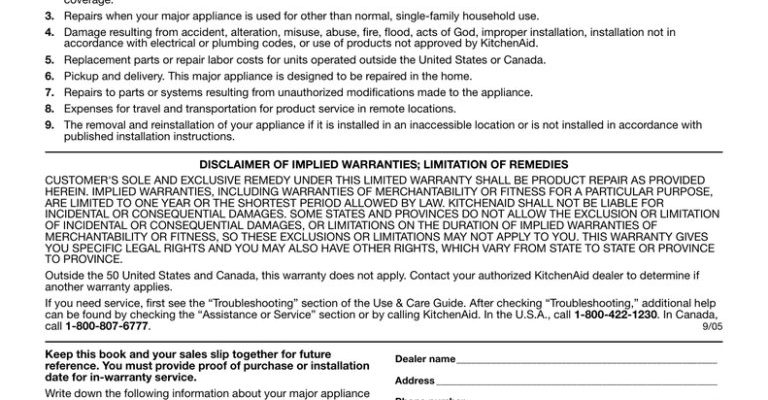
KitchenAid is known for making sturdy, high-quality dishwashers, and their warranties are part of what gives buyers peace of mind. But warranties don’t always behave like lifetime guarantees that stick with the item forever. Often, they’re more like a safety net tied to the original buyer’s name. If you’re thinking about selling or gifting your KitchenAid dishwasher, knowing the ins and outs of warranty transferability can save you (and the new owner) time and headaches.
Understanding KitchenAid’s Warranty Basics
Before diving into whether the warranty can be transferred, it helps to understand what KitchenAid’s warranty actually covers. Most KitchenAid dishwashers come with a limited warranty—usually one year from the date of purchase. This warranty generally covers parts and labor if there’s a manufacturing defect or a problem with the appliance that’s not caused by user damage.
Here’s the thing: KitchenAid’s standard warranty is often tied to the original purchaser and the original purchase date. This means the warranty clock starts ticking when you, the first buyer, made the purchase. It’s less like a “set it and forget it” deal and more like a countdown that doesn’t reset or pause when ownership changes.
Also, KitchenAid makes it clear that their warranty doesn’t cover damage from normal wear and tear, accidents, misuse, or improper installation. If you’ve been gentle and followed all the manufacturer’s instructions, you’re on solid ground—but if the dishwasher has been through the wringer, warranty repairs might not apply anyway.
Can You Transfer the Warranty to Someone Else?
You might be thinking, “Okay, but if I sell or give my KitchenAid dishwasher to a new owner, does the warranty transfer to them?” Honestly, the answer isn’t a simple yes or no—it depends on a few factors.
KitchenAid’s limited warranty does not officially allow for warranty transfer. This means that the warranty protection stays with the original purchaser. If the new owner tries to use the warranty, KitchenAid typically requires proof of the initial purchase and will only honor repairs or replacements under the original warranty period. The new owner isn’t technically covered under a new or extended warranty simply by taking over the appliance.
That said, if the dishwasher is still within the warranty period and you provide the new owner with the original receipt, they might be able to get repairs covered. But keep in mind, KitchenAid customer service might ask questions or verify that the person requesting service is the original buyer. So, it’s not a guaranteed smooth process.
Why Doesn’t KitchenAid Let You Transfer Warranties?
Think about warranties like a personalized contract between the company and the person who bought the product. KitchenAid designs this contract to protect the original purchaser, ensuring they get support during the initial year or so. Allowing warranty transfers would mean KitchenAid would have to track and verify different owners, which complicates things for their service teams.
Plus, warranty transfer restrictions can encourage buyers to purchase from authorized sellers and discourage gray market sales. It’s a way for KitchenAid to maintain quality control and track where their products end up.
What Happens If You Buy a Used KitchenAid Dishwasher?
Buying a used KitchenAid dishwasher can seem like a great deal. But here’s what you need to keep in mind about the warranty. Since KitchenAid warranties generally don’t transfer, a used dishwasher usually doesn’t come with active warranty coverage—unless the original owner gives you the purchase receipt and you’re still within the warranty period.
Otherwise, if the dishwasher has outlived that warranty window or the seller can’t provide proof of purchase, you’re basically buying the appliance “as is.” This means you’d be responsible for any repairs or troubleshooting that come up later on.
In some cases, you might want to consider purchasing an extended or third-party warranty to cover your new (used) dishwasher. Some companies offer protection plans that start from when you buy the appliance, no matter its age.
How to Protect Yourself When Buying or Selling a KitchenAid Dishwasher
Whether you’re selling your dishwasher or buying one secondhand, there are a few smart steps to take so everyone feels confident about warranty status and coverage.
- Keep your original purchase receipt: This is the key to proving when the dishwasher was bought and could be the difference between getting a warranty repair or paying out of pocket.
- Be upfront about warranty status: When selling, tell the buyer if the warranty is active or expired. Transparency helps avoid surprises.
- Check warranty expiration date: If you have the model number or serial code, you can sometimes contact KitchenAid customer service to double-check the warranty period.
- Consider a service plan: If buying used, explore third-party warranties or service contracts to protect yourself.
It’s a little like buying a used car—you want to know if you’re getting roadside assistance or if the brakes will be on you to fix.
Troubleshooting Warranty Coverage Issues
What if you’re the new owner and you have a problem with the dishwasher, but you don’t have the original receipt? Here’s where things get tricky. KitchenAid’s warranty tends to lean on solid proof of purchase before stepping in.
If you find yourself in this spot, here’s what you can do:
- Contact KitchenAid customer support: Explain your situation. Sometimes they can help if the serial number shows recent manufacture or sale.
- Check your dishwasher’s model and serial number: These are usually on a label inside the door frame, and they can reveal the manufacture date.
- Try basic troubleshooting: Problems like error codes or reset issues often have straightforward fixes that don’t require a warranty claim.
- Get a professional diagnosis: A licensed technician might be able to repair the dishwasher without needing warranty authorization.
Honestly, it can be frustrating if you don’t have the receipt. But sometimes a bit of detective work and patience goes a long way.
Are There Alternatives or Extended Warranty Options?
If transferring the KitchenAid warranty isn’t an option, what else can you do? Well, the appliance world offers some alternatives to keep your dishwasher running smoothly.
- Extended manufacturer warranties: KitchenAid and retailers sometimes sell extended plans at the time of purchase. These usually don’t transfer, but if you’re buying new, they can add years of coverage.
- Third-party protection plans: Companies like SquareTrade or Asurion provide coverage on appliances regardless of the manufacturer’s warranty. These can be purchased when buying used dishwashers.
- Regular maintenance: Maintaining your dishwasher—cleaning filters, checking hoses, and running diagnostics—can prevent many common issues without needing warranty service.
- Universal troubleshooting guides: Some fixes are simple, like resetting the dishwasher or replacing batteries in the remote control panel, which anyone can do without warranty help.
These alternatives help you keep your dishwasher humming along, with or without a formal warranty transfer.
Wrapping It All Up
So, can you transfer warranty on a KitchenAid dishwasher to a new owner? Unfortunately, KitchenAid’s warranty is generally non-transferable. It’s tied to the original purchaser and the original purchase date. While the new owner might still benefit from warranty coverage if they have the receipt and the warranty period hasn’t expired, KitchenAid’s policies don’t officially support transferring coverage simply by changing hands.
If you’re selling or buying a used KitchenAid dishwasher, the best bet is to keep all purchase paperwork handy, be transparent about warranty status, and consider additional protection plans if needed. And remember, many dishwasher problems can be fixed with basic troubleshooting or professional repair without warranty drama.
At the end of the day, a KitchenAid dishwasher is a solid companion in the kitchen—just treat the warranty like a personal ticket, not a transferable gift. That way, everyone knows what they’re working with as the appliance changes hands.
